With the 3-5-2 and 4-4-2 back in fashion, the football world is rediscovering the benefits of two forward systems. Of the four teams to secure passage to the UEFA Champions League quarterfinals, three clubs feature two up top, though it’s absurd to paint the systems of Atlético Madrid, PSG and Atalanta with the same brush.
In this training article, we’ll start with the differences in runs behind the lines between two and three forward systems, which connects to last week’s analysis. With those contrasting ideas in place, this tactical analysis will set out the tactical argument for narrow, more direct runs behind the lines. This is especially important for teams lining up with a diamond midfield. We’ll then turn to a flat midfield system, be it in a four or five-player configuration. Finally, I’ll share some exercises to train your team to make runs behind the lines in a two forward setup.
Differences in runs between two and three forward systems
In my training analysis article entitled, “Coaching: Training runs behind the backline in a three forward system,” I went in-depth on the types of runs in behind defences utilised by the game’s top teams. The centre-forwards played a major role in these runs, though typically for the sake of a teammate. In a three forward system, teams like Real Madrid like to isolate the wide forwards, enabling them to either run onto a pass sent behind the lines, typically in the half-space, or running at a defender 1v1. With the current Barcelona squad, the front three are very narrow, offering vertical runs and outlets for deep completions and combination play. In either situation, the three forwards are tasked with occupying the entirety of the opposition’s backline.
In a two forward system, the occupation of the opposition’s backline is more targeted. In the majority of these tactical systems, the two forwards look to occupy just the centre-backs. They might position themselves between a centre and outside-back on occasion, but it’s nearly always the central player’s responsibility to pick up the central forward.
If a team has two forwards, odds are they’re playing 4-4-2, 3-5-2 or some variation of those formations. The obvious advantage of two up top is numerical equality deep in the central channel. That’s difficult to achieve in one and three forward systems, primarily because additional arrivals bring additional defenders.
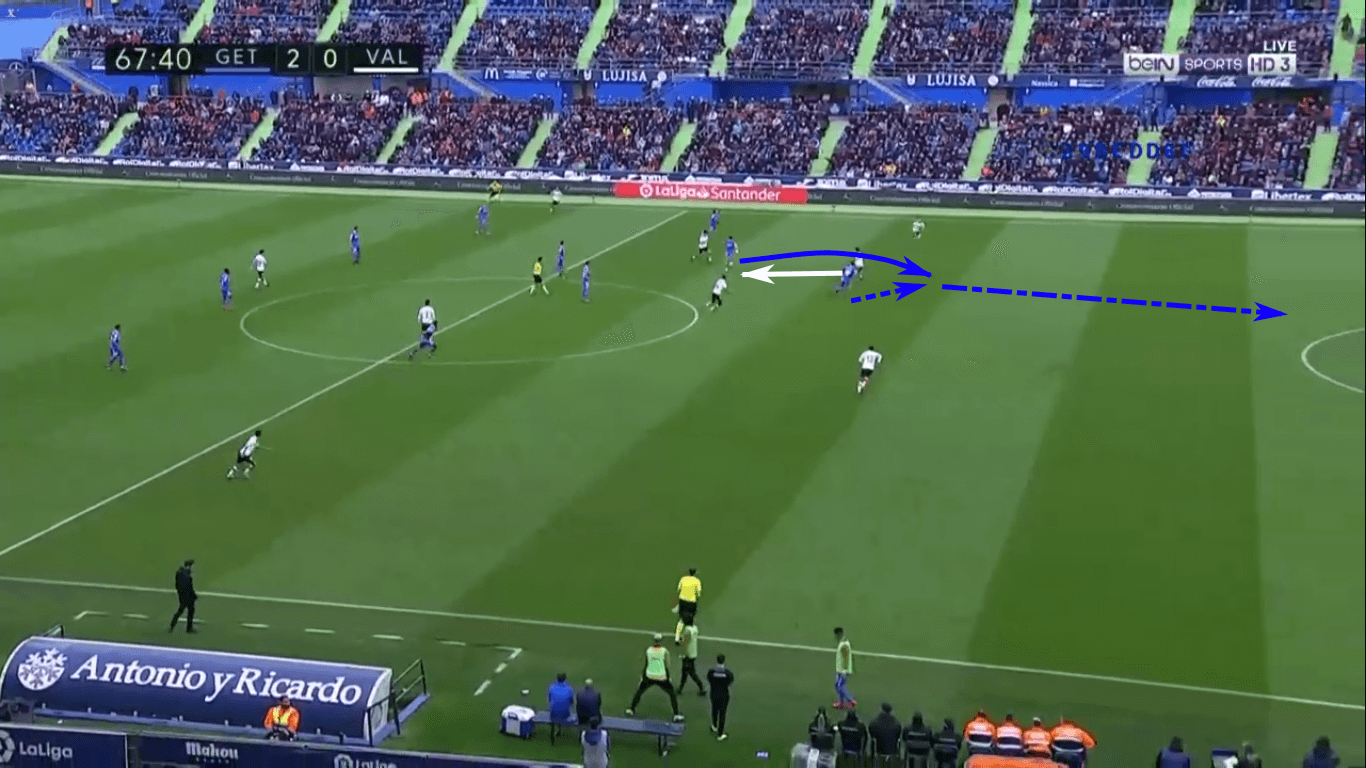
A diamond midfield is generally utilised in the 4-4-2, particularly if a team’s defensive tactics prioritize counter-pressing and/or high pressing. It gives sides natural layers in and out of possession, plus the players are deeply connected throughout the pitch, overwhelming the opposition through numerical superiority and triangulated starting points. With this midfield structure, teams are likely to play more directly, using their numerical advantage near the ball and two high outlets before the opposition can transition to a more compact defensive shape. With this setup, you’ll see the centre-forwards coordinating their movements to free space behind the lines, either for each other or one of the midfielders. In the above image, you see Getafe narrowing the pitch defensively, Jaime Mata recovering the ball and then playing Jorge Molina behind the lines. Though the veteran was caught, a breath-taking individual display saw him pick up his second goal of the match.
For clubs sporting the flat midfield, the skill sets of the two forwards can vary significantly. Combinations include target player and second striker, attacking forward and trequartista or even two complete forwards who can do it all. While that’s not an exhaustive list, it gives an idea of the possibilities. While the vertical pass over or through the lines is always an option, you tend to see teams with a flat midfield progress up the wings. Even though the wingers aren’t running behind everyone in the line, they’re running behind the outside-back.
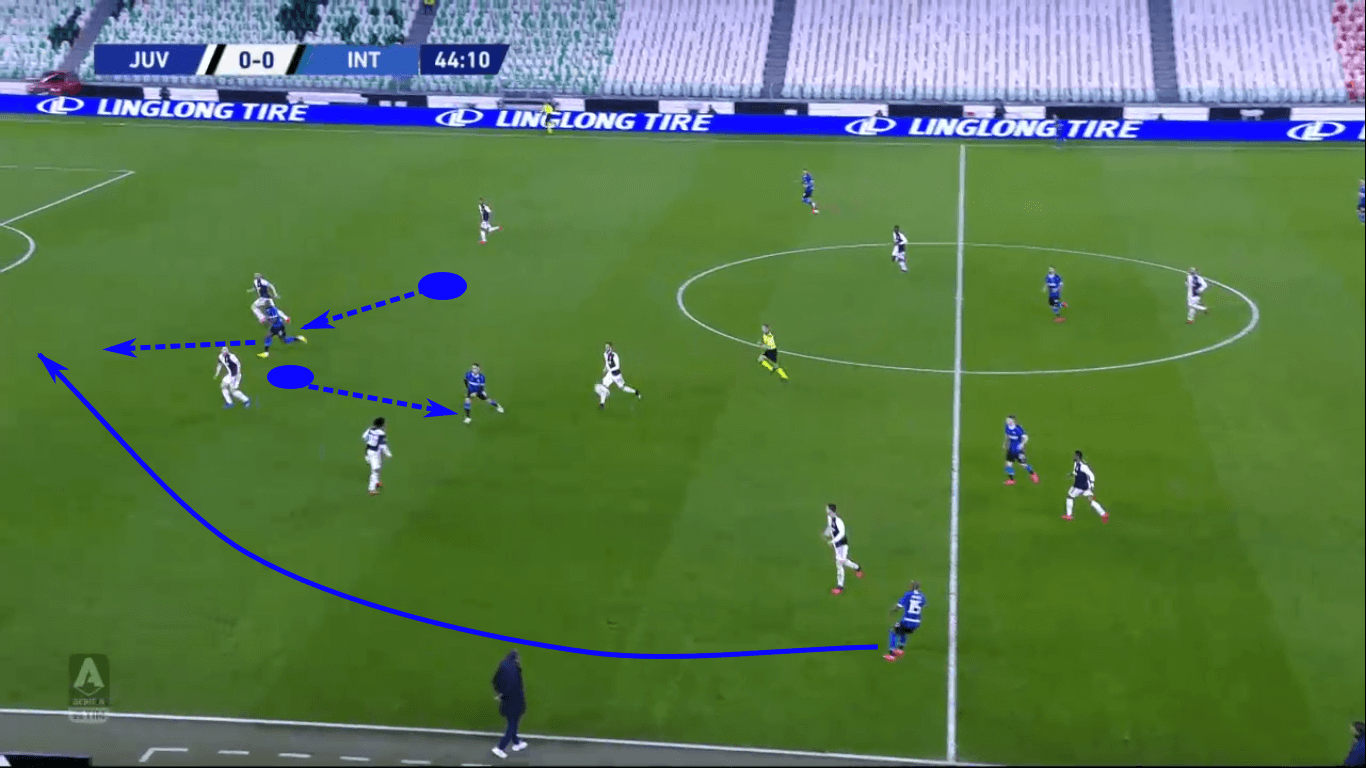
Inter Milan are fortunate to have two complete forwards in their lineup. Romelu Lukaku and Lautaro Martínez can do it all for the Serie A giants and the pair have shown a fantastic understanding of each other’s playing habits. In the match against Juventus, we saw Martínez start high near Matthijs de Ligt, then quickly drop into the midfield to offer Ashley Young an outlet. Though De Ligt did well not to chase Martínez into the midfield, Lukaku was still able to get a step on Leonardo Bonucci and make his run behind De Ligt. Young overhit the pass, ending the attack, but you can see the coordinated movements of the two forwards. Had Lukaku collected the pass, he knows Martínez would have dashed to the penalty arch in support.
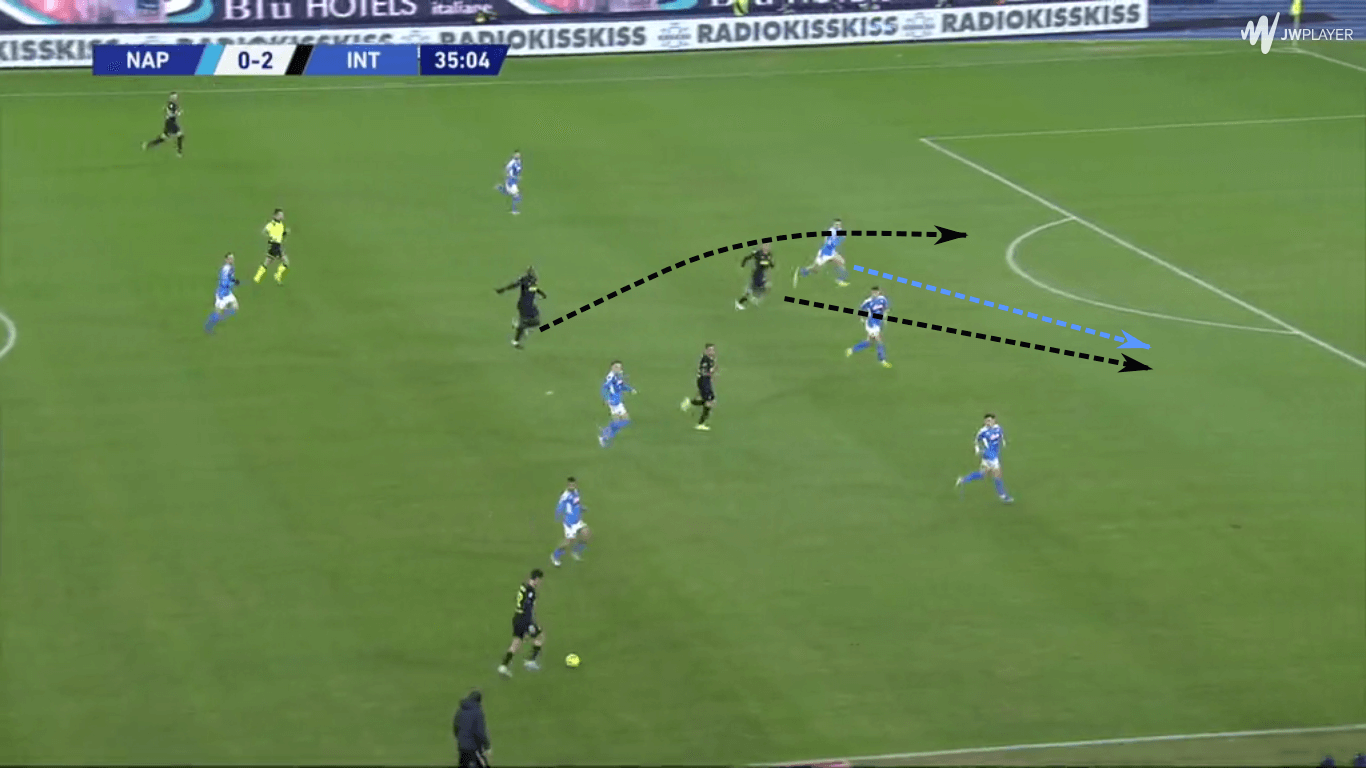
Sticking with the Inter pair, though this time against Gennaro Gattuso’s Napoli, Matias Vecino and Lukaku had switched roles while Martínez started high in the central channel against the right-centre-back. With the far-sided centre-back covering him and Lukaku underneath, Martínez took off behind the lines into the right-half space. Rather than passing Martínez off to Giovanni Di Lorenzo, Konstantinos Manolas ran with him. That gave Lukaku a clear route to goal, which, again, was not played. Though Inter failed to capitalize on the opportunity, the two forwards gave us another excellent example of coordinated runs behind the backline.
Runs suiting narrow, more direct attacks
Though it’s worth acknowledging the wide variability of tactics in two forward systems, we’re going to simplify our approach. In this section, we’ll analyse more narrow attacks in a diamond midfield, much like Getafe’s, before moving onto a more wing dominant system, like Atlético Madrid’s.
To play a narrower, direct style, you can certainly keep it simple and use your team’s version of Usain Bolt to run past opponents. If you don’t have that type of player, you need to find another way to beat the two centre-backs. Remember, they’re typically great athletes, fast enough to run with most opponents and strong enough to fight back, so the odds of Route 1 football working are quite slim at the top levels, even in the youth game.
After studying a number of two forward systems, it was clear that Getafe were among the best, if not the top, in utilising a direct attack with a 4-4-2 diamond. Despite the age of the squad, low wage bill and little transfer money in the coffers, José Bordalás’ tactics have this side one place out of UEFA Champions League qualification.
One clever aspect of his attacking tactics is the central-forward overload. You’ll often see Mata and Molina side-by-side, but, as the opposition’s midfield presses higher and leaves a gap between the lines, the far-sided forward will drop in front of the other. Suddenly, they’re 2v1 in the central channel or half-space. The forward on the ball will run at his teammate’s defender while the higher of the two wheels around to correct his body orientation for the run behind the line. With the centre-back pinned, the through ball is played.
Perhaps the key concept is that 2v1s are even more advantageous than 2v2s. Among the elite sides playing a two forward system, most will look to approach it as 2v2s with the hope of creating a 1v1. Think of the Inter Milan images earlier in this analysis. One forward pulled a centre-back out of the middle, giving his teammate a 1v1. Given the individual quality in those sides, that approach is understandable.
At Getafe, the tactics often see the side experience more success when they’ve created a 2v1 high up the pitch. That cues the run behind the line and frees the passer to make a run of his own in the central channel. It’s a really clever system and one to utilise in your training sessions.
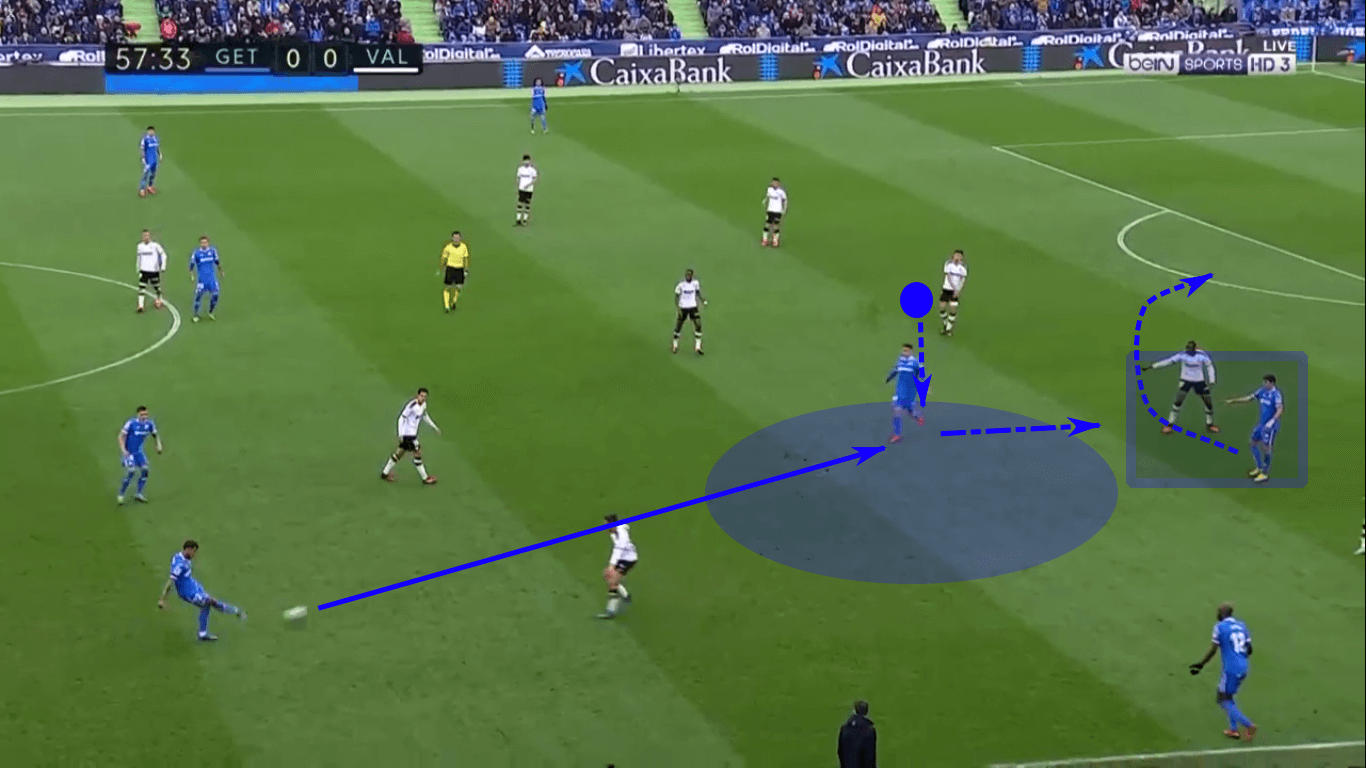
In an early February La Liga match against Valencia, Getafe was in an open possession against a set Valencia defence. This is a perfect example of coordinated movements in a two forward system. Mata is pinning Mouctar Diakhaby high up the pitch, opening up a massive gap for Molina to run into. If Diakhaby had stepped forward to pressure, Molina could have played Allan Nyom on the wing, who could have played Mata behind the lines in the space Diakhaby vacated. With Molina receiving between the lines, he had time to pivot on the half-turn and run at the backline. As Molina received, Mata started his run centrally, allowing his teammate to run at the isolated Diakhaby.
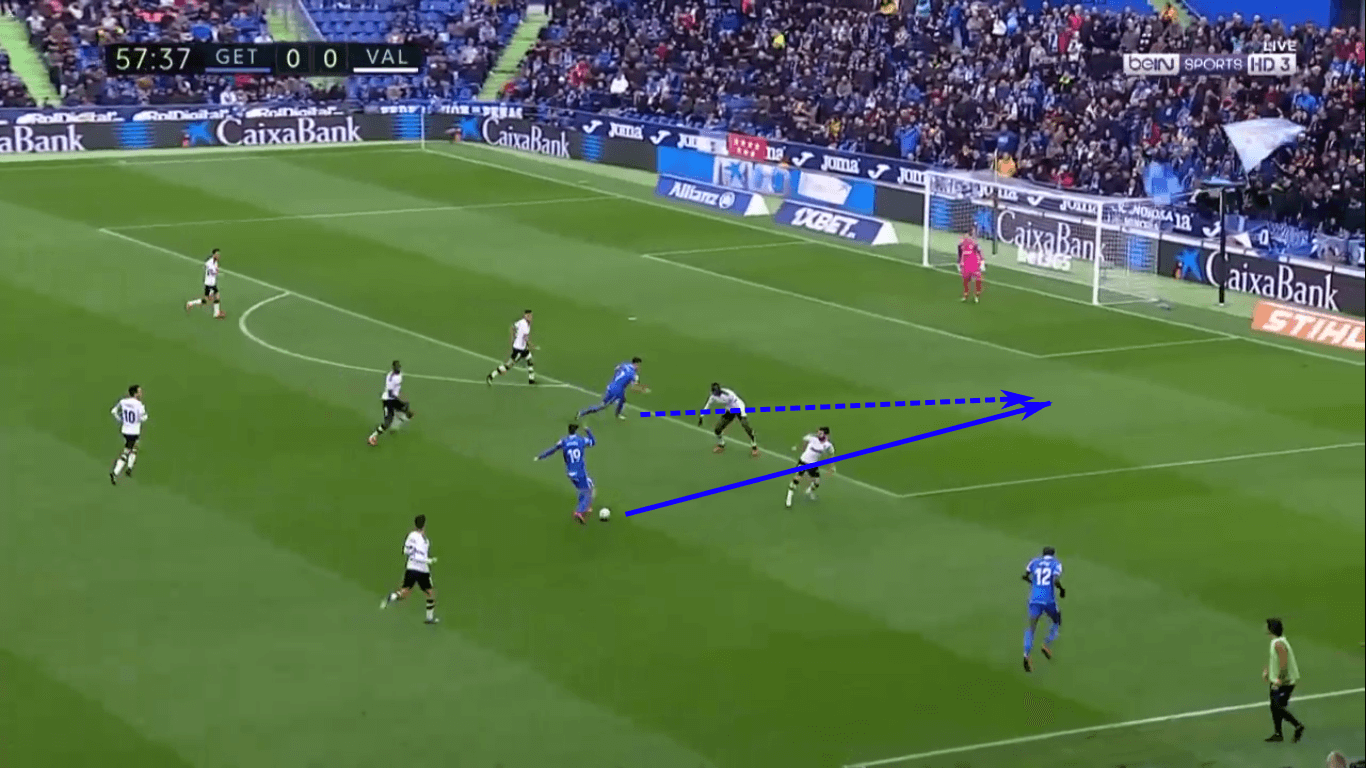
Once Diakhaby decided to stand his ground, Molina played a simple through ball onto the run of Mata. Though this is a simple construction, the two forwards did well to keep the 2v1 in their favour and get behind the line.
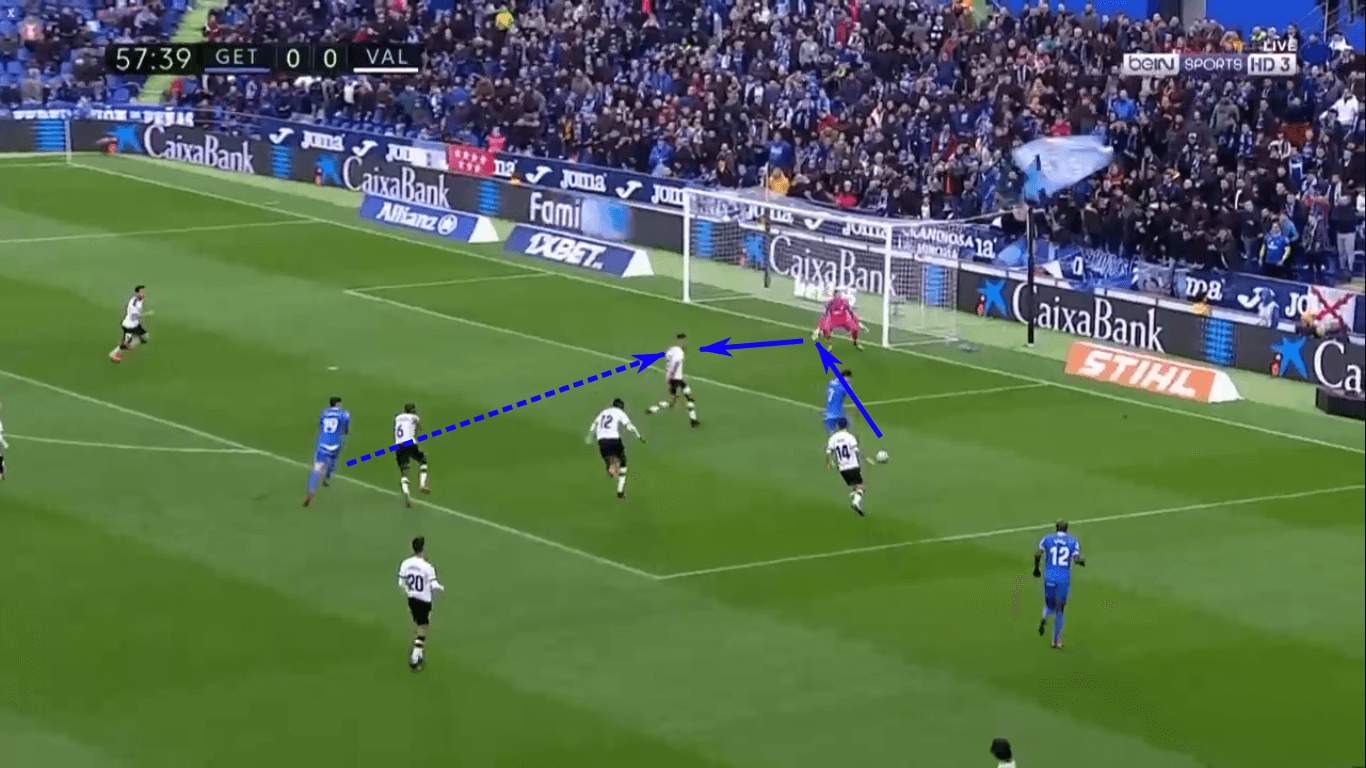
Mata’s shot was blocked, but right into the path of Molina. In this sequence, we’ve seen the two forwards look to take up positions in the same vertical channel, pin one defender, run behind the lines and the repeat. The lack of attacking symmetry threw Valencia into a state of chaos. Getafe are a brilliant example of narrow, direct attacks that overload and pin the opposition. Move with the forwards and other parts of the field become vulnerable. Keep your shape and they overwhelm you with their numerical advantage. It’s a brilliant tactical approach, one that sees the low-budget Spanish side in the Round of 16 of the Europa League and fifth in La Liga.
Getting the wingers behind their marks
Unless you’ve lived under a rock for the last decade, you’ve surely seen Diego Simeone’s Atlético staunchly defend in a low block, then hit the opposition with a lightning-quick counterattack. While his sides have typically shown the preference to play right down the central channel, this current side sees the wide midfielders progressing the ball in the final third.
The two forwards are still a big part of this tactic. Whether it’s Alvaro Morata or Diego Costa operating in target roles or the likes of João Félix or Ángel Correa dropping between the lines, this side likes to play its wide midfielders behind the opposition’s outside-backs. But why?
As teams get into their attacking shape, the outside-backs push higher up the pitch to participate in the attack. You can make an argument that the playmakers of the modern game are more frequently played in the wings. Think of Marcelo and Dani Alves. With all the space out wide, they were able to beat the first line of pressure and wreak havoc on the next. In both a 4-4-2 flat midfield and 3-5-2, that leaves your wingers with loads of space in the counterattack. Progression is typically much easier on the wings because your wide midfielder only has to make his run behind the opposition’s ill-positioned outside-back. Plus, once you get behind the outside-back, the whole backline has to adjust their shape.
In flat midfields with true wingers, teams target the centre-forwards before playing wide to funnel the opposition centrally. With the accomplished, the strikers can then hold up play until the wide midfielder makes his run behind his counterpart. If this pass is successful, the two central forwards can run through to goal knowing that one of the centre-backs will step out to contain the dribble. Ultimately, it’s the run behind the outside-back that gives the two central forwards more freedom to move into goal-threatening positions.
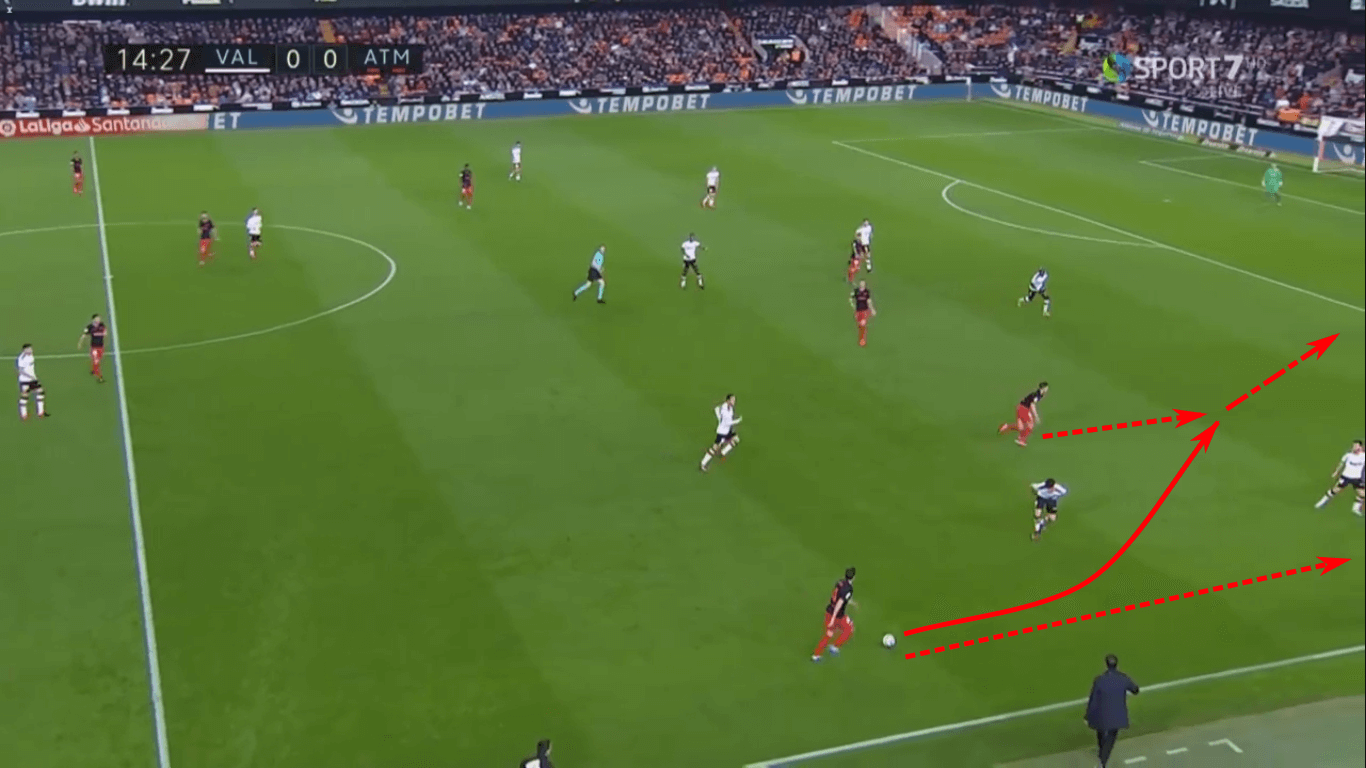
I hate to pick on Valencia again, but they’ve left me no choice. In a Valentine’s Day La Liga fixture, Atlético Madrid travelled to Valencia to a battle of the 4-4-2 flat midfields. Much like the tactics, the result was one of equality (2-2). Here we see Vitolo swap roles with Marco Llorente and Correa move into the left-half space. As Carlos Soler pushed higher to pressure Vitolo, the Spaniard bent a pass that split the Valencia defence onto the run of Correa.
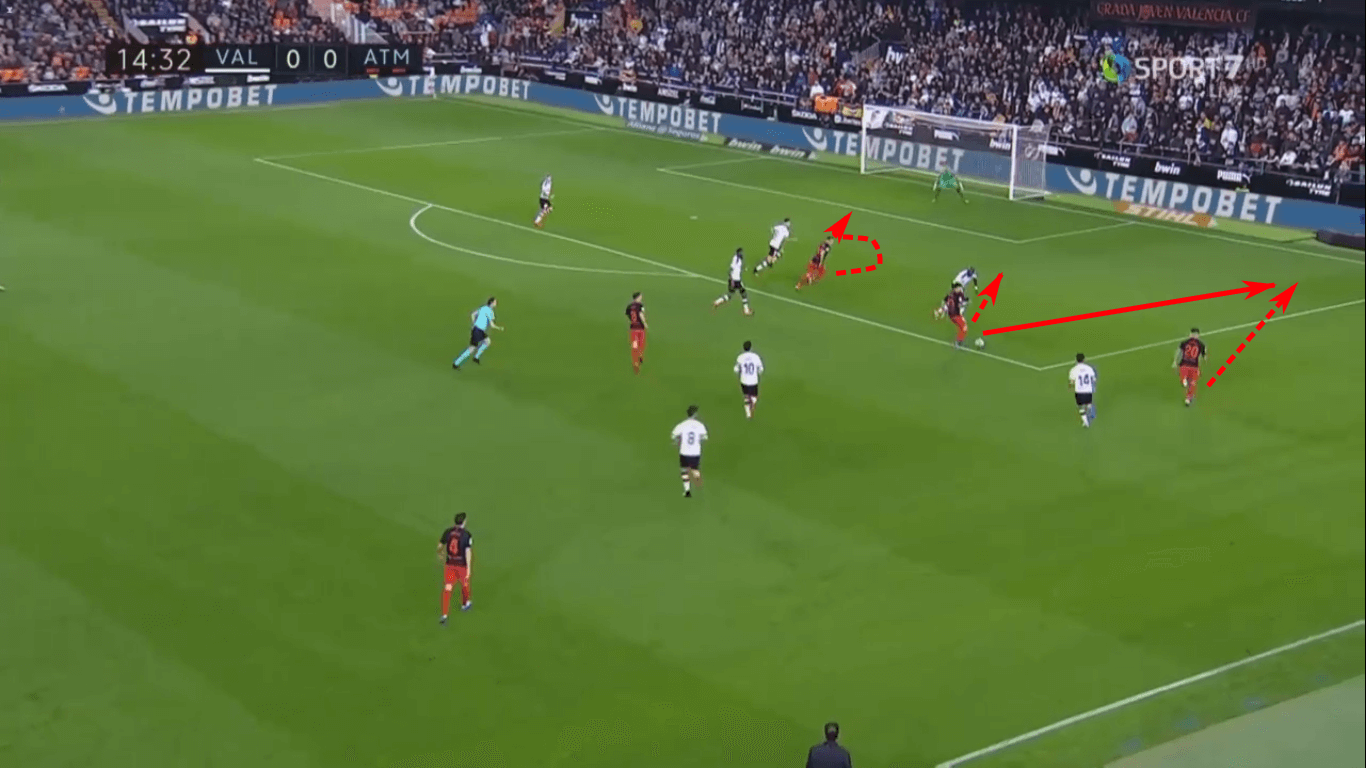
The forward progressed play into the box, drawing the attention of Eliaquim Mangala. Vitolo’s initial pass was followed by a sprint down the wing, moving him past the left-back, José Gayà. Correa returned the ball to Vitolo while Llorente took up a more central position off the shoulder of the right-centre-back, Gabriel Paulista.
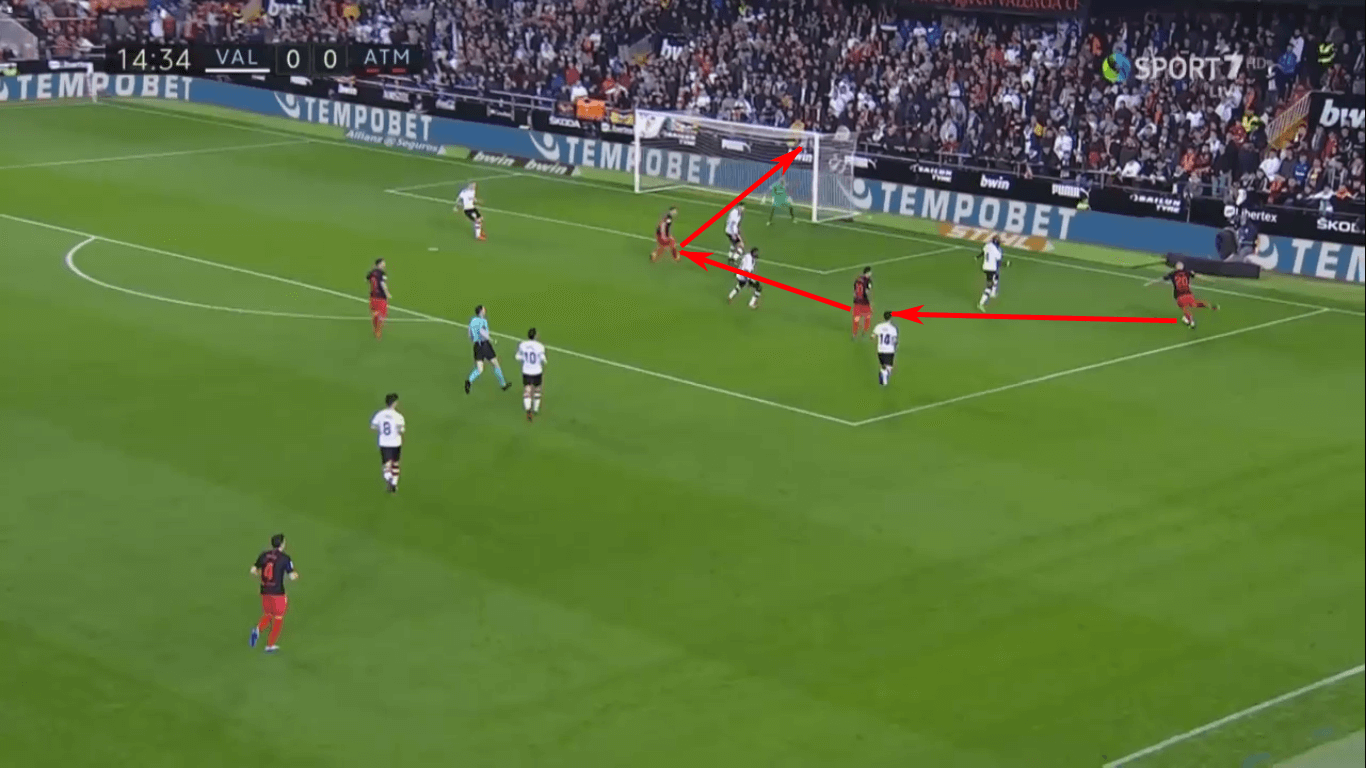
With Mangala forced to continue to Vitolo, Correa stopped his run, opening up the return pass. Correa hit it centrally with his first touch, finding Llorente for the opening goal. Though the initial run was into the half-space, a follow-up run in the wing allowed Atlético to push Valencia’s defence out wide, opening up the middle for Llorente’s finish. Correa’s intelligence to find the initial gap, then Vitolo’s hustle to run behind Gayà were the critical movements in the sequence. Without their runs behind the lines, Valencia would have comfortably kept play in front of them, nullifying the Atlético with the numbers they had behind the ball. Instead, the runs disoriented the Valencia defence, allowing the Madrid side to capitalize on the positional mistakes of their opponent.
Exercise 1 – for diamond midfields
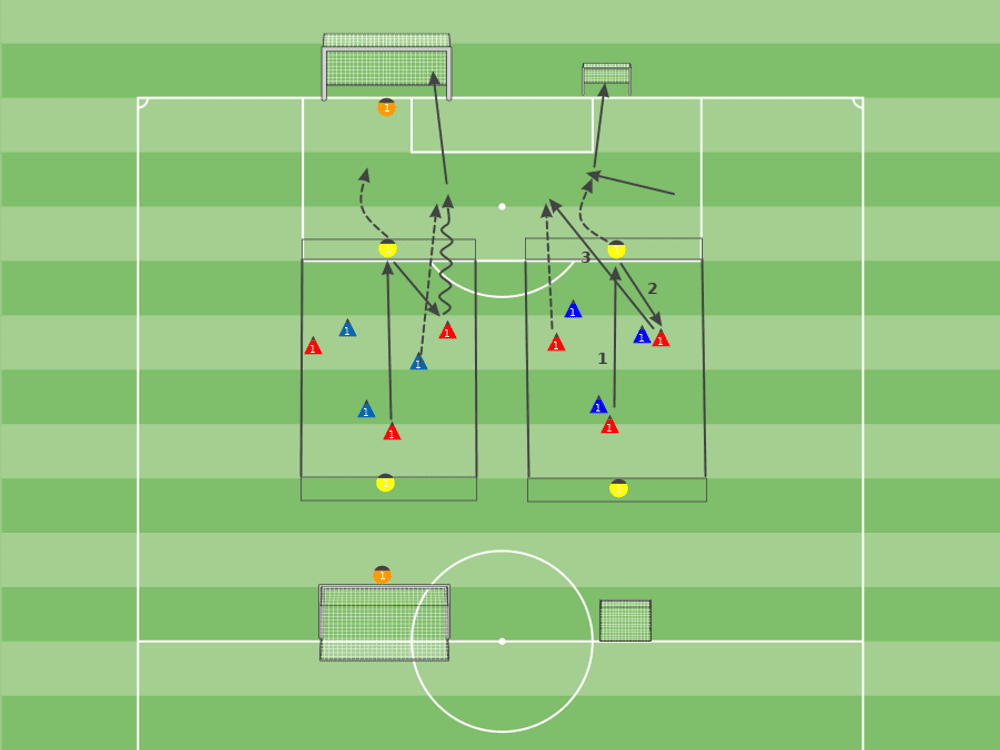
Organization
- Field measures 12v24. Give an additional three metres -depth per endzone.
- Two teams of three with one target player in each endzone.
- When possible, feature goalkeepers in regulation-sized goals, as seen on the left-sided pitch. If this is not an option, replace the regulation-sized goals with mini-goals.
- Optional: For a progression, add a midfield line to keep track of offsides. You can emphasis the long pass to the high target or a through ball to a field player, who then plays his target player before the two can attack the goal.
Gameplay
Before a team can go to goal, they must first play their target player. He has the option of setting back and then running onto goal or playing his teammate behind the defence. On the left side of the image, we see the target player laying the ball off for a teammate who’s behind his defender. On the right, the target player’s set allows the attacking team to play the third runner behind the lines. Look for and praise these patterns. If the ball goes out of play, restart play from the keeper. This is an ideal warm-up, lasting approximately 15 minutes.
Coaching points
- Correct body orientation to connect actions
- Field players anticipating passes into the target and making runs in behind
- Play long to target when possible. If it’s not on, play short and keep possession.
- Watch for the proper technical execution of the set
- If a field player is the third attacker and his teammates have the option to play directly to the target, drift behind your defender to gain a few extra metres
Exercise 2 – for flat midfields
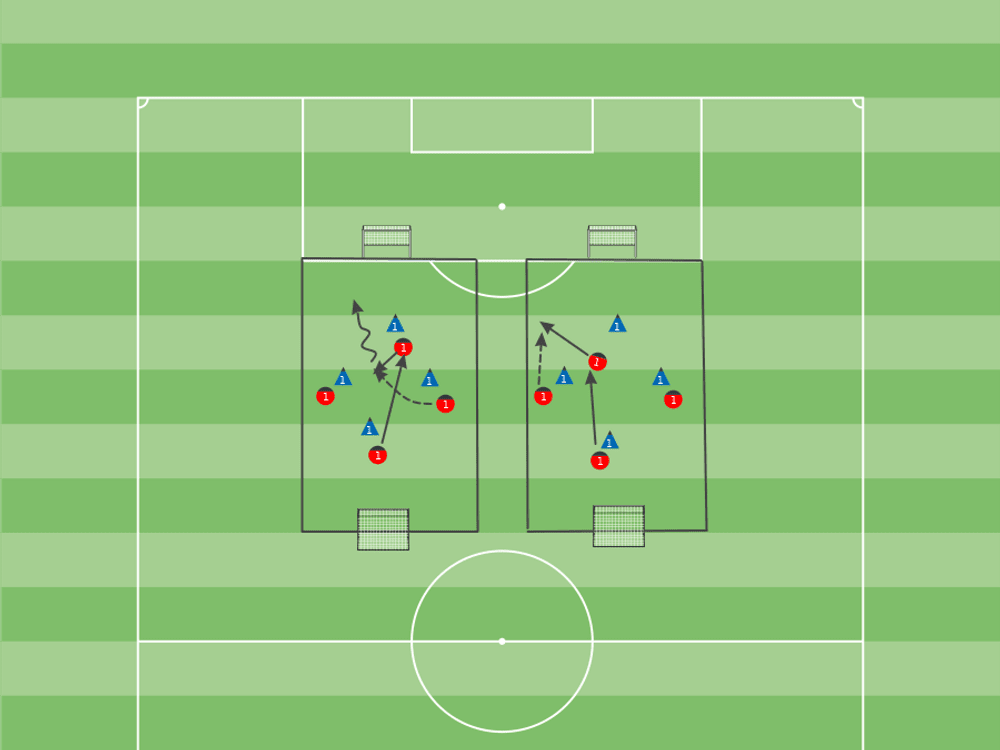
Organization
- Field measures 12v24
- Two teams of four
- Two mini-goals per pitch
Gameplay
A simple 4v4 street soccer style competition with round-robin or championship/consolation fields. Teams must have at least one high target in the formation. This is an ideal warm-up, lasting approximately 15 minutes.
Progression: Add a man-marking element for increased fitness training and accountability.
Coaching points
- Correct body orientation to connect actions
- High target must create space in the wings for his team. He has a number of options available, including starting high to disconnect the final defender from coverage, shifting to one wing to create a running lane for the far-sided winger, pulling the last defender into the midfield to open up through ball for the winger, etc. Watch the target player’s movements. If his team is struggling to get behind the opponent, make a diagnosis as to whether it’s the high target or his support players who are behind the play.
- Quality of the passes to wide players. The #9 must look to get the wingers running behind the lines.
- Active wingers, especially as the third runner or the endpoint of combo play
- If a field player is the third attacker and his teammates have the option to play directly to the target, drift behind your defender to gain a few extra metres
Exercise 3
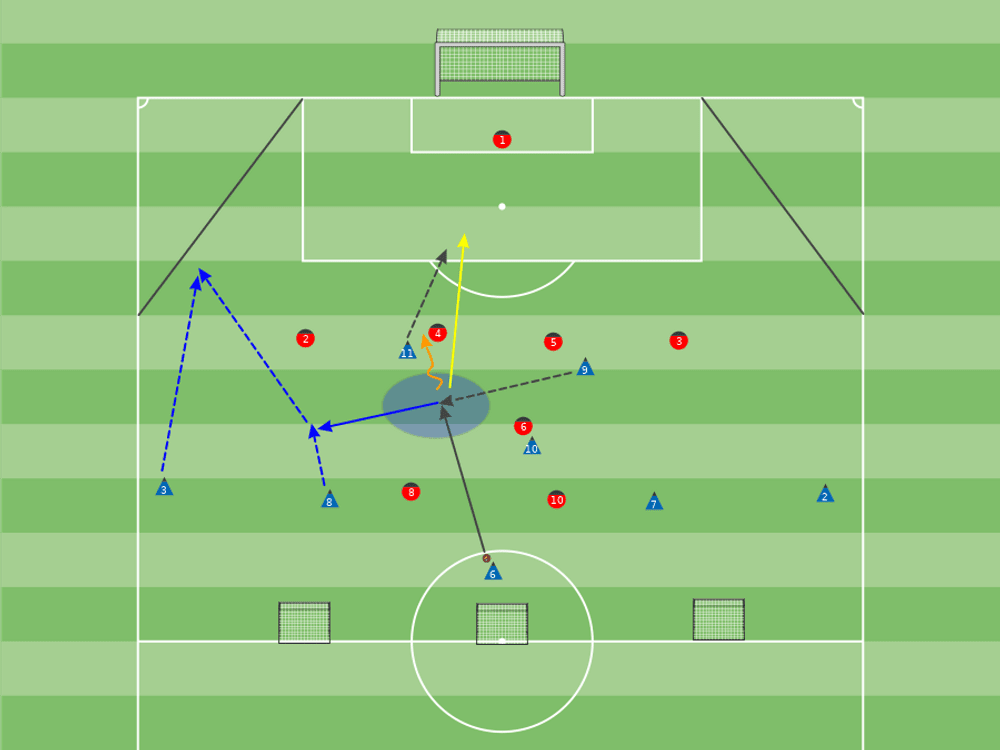
Organization
- Half the pitch, minus the corners. Those diagonal lines start approximately 24 metres from the endline.
- 8v7+GK
- Blue team features two outside-backs, four midfielders (diamond or flat to fit your tactics) and two strikers. For teams that play 3-5-2 or some variation of that formation (like Atalanta’s 3-4-1-2), feel free to change the blue team’s formation to a 1-5-2. You can also change the red team’s shape to fit an upcoming opponent’s tactics.
- Blue plays to full-sized goal, red to three mini-goals
Gameplay
Progressing from the first exercise, the blue team starts play from midfield and looks to play runners behind the backline. As a progression, if the defence is dropping too deep, have an offside line that the attacking team must pass over (no dribbling). Run this exercise for approximately 25 minutes, giving a one-minute rest after each five minute round.
Coaching points
- All coaching points from the first exercise (look for continuity in the session)
- If you play a diamond midfield, emphasize the vertical run of one forward and corresponding diagonal drop as illustrated. This is still a coaching point for teams fielding a flat midfield, but the forwards in this system are more likely to activate the wingers than take a direct approach.
- Play between the lines to help create and drag defenders out of their lines
- Two central forwards occupying the centre-backs and manipulating their positioning
- For diamond midfields, willingness of the #10 and two box-to-box midfielders to run behind the lines in the central channel and half spaces
- For a flat midfield, you want to see your wingers drawing the opposing outside-back higher up the pitch, disconnecting him from his help. That allows the attacking team’s wingers to run behind the backline. Further, if blue gets behind red in the wings, can they run towards goal, pinning the nearer of the two centre-backs to free a blue centre-forward to run behind the line.
- Watch for situations where the attacking team could have better utilized the third runner
Exercise 4
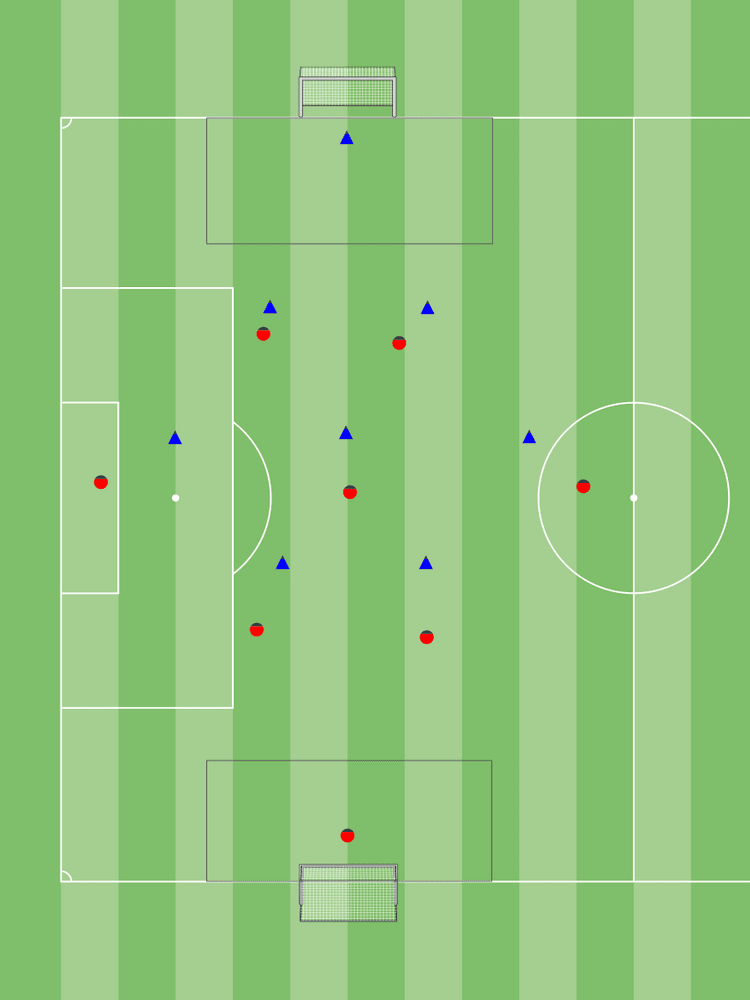
Organization
- Half field, using 9v9 lines if your pitch has them
- 8v8 going to full-sized goals
- Teams in a 2-3-2 formation. Shape the midfield to fit your tactics.
Gameplay
This is another opportunity to give players the freedom to implement the ideas from the session. Your job is to quietly observe and note the concepts that they’ve understood and where the team needs help. Play for 30 minutes, breaking the exercise into three, eight-minute rounds. During the breaks, use guided questions to help them identify what’s going wrong and discover possible solutions.
Coaching points
Reinforce all prior coaching points.
Conclusion
I hope you’ve enjoyed this two-part series and come away with valuable insights related to runs behind the lines, both in two and three forward tactical systems. When training these tactics with your team, be patient with the process while helping your players identify the cues that should spark action. If the players are struggling, one thing you’ll notice is that they’re too focused on the action near the ball, neglecting the individual matchup in front of them. If a player is not directly involved in the play, ask them what they can do to present a better option when play shifts in their direction. Ideally, they’ll mention your coaching points before you do. That’s a fantastic sign, one that shows you have intellectual players who were simply focused on the wrong information. If the player’s intelligent and a willing runner, you’ll be amazed by the quick progression.





Comments